Forte, Sorento bolster Kia armada for 2014
By John Gilbert
SCOTTSDALE, ARIZ. — Introducing two vehicles at the same time is a sketchy proposition for an auto manufacturer, because neither can attain full emphasis. But Kia is in a hurry, and with seven specific launches in the coming year, there is no choice but to package them together — which is why the 2014 Sorento SUV and Forte compact sedan both were presented together for introductory tests in the hills and desert of Arizona.
When I got my turn to drive the new Sorento and Forte, I was accompanied by Steven Hirashiki, a Kia product strategy fellow, instead of another auto journalist. That was good for a variety of reasons: I had to go directly from our lunch stop to the Phoenix airport for my return flight to Minnesota, he was able to answer some of my questions, I was able to respond to his questions about what I liked and didn’t like, and, mainly, I got to drive the whole day instead of trading turns behind the wheels.
In both cases, the vehicles performed well in assorted runs on highwayts, up0 and down hills, around curves, and in city traffic. While longer drives in both vehicles will be upcoming, my brief drives were properly impressive.
The Sorento has become one of the more successful and impressive SUVs for a changing marketplace, doing the work of large SUVs but with the agility and fuel efficiency of more compact models. And the new model improves on that already-impressive model in every way. The 3.3 engine upgrade is now truly upgraded because it has gas-direct-injection, a technique that improves both power and fuel-efficiency. Its appearance has been tweaked a bit, and the interior is easy to like. I found the performance good, although a couple of times it had a prominent jerk on acceleration at low speeds — s0mething that could improve as more miles accumulate. The steering was improved considerably, and so was the cornering stability.
The Forte never caught on in a big way when introduced in 2009, possibly due to the overwhelming response to the larger Optima and to the smaller Rio, plus the squarish Soul — which benefits by Kia’s reluctant but ultimate acceptance that the big hamsters are a lovable and popular trademark. The new Forte upgrades its design features, and its more-dashing exterior is matched by the interior Plus, the steering has a much better feel, as does the steering wheel itself, and the cornering is more precise and better reacting, as is the power in the optional 2.0-liter engine.
My biggest criticism of both vehicles — as well as all Hyndais and Kias — remains that the proud South Korean company,is more loiyal to Korean tire companies than to finding out what tire might help handling the most. That is especially true when drdiving on icy roads in snow-belt areas of the U.S. You can select what tires come on your Sorento or Forte — as long as they are made by Kumho, Nexen, or Hankook. In Minnesota, If I bought any Kia, I would immediately put on some Nokian WR or WR-G2 tires and find that the vehicle is suddenly a top-shelf winter-beater.
The Sorento has been a traditional mainstay that not only has been around during Kia’s meteoric rise in the last four years, but it played a major role in the South Korean company’s rush. In fact, when Kia followed Hyundai, its corporate partner and technological leader, to a major impact in the Southern U.S. five years ago, the Sorento became the top-selling vehicle in Kia’s whole line.
Hyundai built a plant in Montgomery, Ala., then it built an engine plant 50 miles up the freeway, and next came a Kia plant in West Point, Ga., 50 miles further, leaving the engine plant equidistant between the two assembly plants. The trend-setting and historic 2011 Hyundai Sonata came out of the Montgomery plant, which later also added the Kia Optima, while the first vehicle out of West Point’s plant was the Sorento, and that plant later added Hyundai’s Santa Fe.
It became difficult for red-necks and foreign-car cynics to criticize the South Korean twins when they built their stylish new vehicles as well as their high-tech engines right there in Georgia and Alabama — in many ways saving the economy of that whole region.
While the Sorento and Santa Fe shared platforms, the Sorento was clearly more stylish, and became a distinct alternative to the great proliferation of midsize SUVs at a time when high fuel costs and poor mileage large SUVs both caused a major shift in consumer preferences. Along with its good looks, the Sorento handled well, got decent fuel economy, and had the availability of a third-row seat. Nothing about the 2012 Sorento indicates it is outdated in any way, but the joint companies have made several corporate alterations.
For one, Hyundai took over Kia’s future at about the time Hyundai had developed its outstanding gas direct-injection (GDI) system on the “Global” 2.4-liter 4-cylinder engine it built and shares with Chrysler LLC and Mitsubishi, and which boosted Hyundai’s Sonata to instant popularity with increases in power and economy. Hyundai/Kia share engineering staffs, and they quickly adapted the GDI technique to other shared engines, such as the 3.3-liter V6, the 2.0-liter 4, and the 1.6-liter 4 that powers both the Rio and Hyundai’s Accent and Veloster. The award-winning 4.6 and 5.0 V8 engines also have direct injection, leaving only the 1.8 with port injection, for the 2011 Hyundai Car of the Year Elantra, and Kia’s cousin, the Forte.
Kia, meanwhile, had pulled a fast one by hiring Peter Schreyer away from Audi, and the highly acclaimed designer immediately put his pen to paper to create the 2011 Optima, a cousin to the Sonata that some think is more stylish. He followed with the new Forte, a pleasant-looking compact, plus the compact SUV Sportage, and subcompact Rio. Hyundai, realizing the benefits of being guided by Schreyer’s fine hand, recently named him as chief designer for both companies.
Hyundai just brought out a completely redone Santa Fe, in both short and long style, so it made perfect sense for Kia to adapt to that platform and bring out a thoroughly updated Sorento. Both the Sorento and Santa Fe are being built in the West Point, Ga., plant.
“It’s an all-new platform, in fact 80 percent of the Sorento is new,” said Orth Haedrick, director of project planning. “It has a subframe in the rear, and it has much-improved handling. There is more room in the second-row seat, plus the second-row seat moves fore and aft to allow use of the third-row seat, if needed. We don’t offer two lengths, like the Santa Fe, but we think we’ve hit the sweet spot, because we’re one of the few vehicles of this size that offers a third-row seat, which can be folded down for extra storage space, and left that way, but if you need it, you can flip it up to go from five to seven passengers.”
The Sorento will hit showrooms in the second quarter of 2013 as a 2014 model, and it comes in four models — a base LX, EX, SX, and Limited, ranging in price from $24,000 to $39,700, depending on the model and equipment. All the trendiest contemporary features are available, including a unique UVO connectivity idea, plus a power liftgate, panoramic sunroof, blind-spot surround detection, and Napa leather seats with wood trim on the interior.
At 184.4 inches long, on a 106.3-inch wheelbase, the Sorento is 74.2 inches wide and 66.9 inches high, or 68.3 if you select a sunroof. Curb weight ranges from 3,594 pounds to 3,722 in front-wheel-drive units, or 3,766 to 3,894 pounds in the more fully appointed all-wheel-drive versions. Wheels start at 17-inch, move up to 18, and have a top 19-inch alloy.
The previous Sorento used the port-injected 2.4-liter 4, but base engine in the new one is the GDI 2.4, with the GDI boosting horsepower by 20, to 191 at 6,300 RPMs, with 181 foot-pounds of torque at 4,250. The previous upgrade for all-wheel-drive versions was a 3.5-liter V6, but that is replaced by a slick, GDI 3.3 V6 that boosts power to 290 horsepower at 6,400 revs, and 252 foot-pounds of torque at 5,200 revs. The AWD models have a new Torque on Demand system, which apportions torque front, rear, or to whichever wheel needs it most.
The new chassis has an 18 percent increase in torsional rigidity, and FlexSteer allows the driver to select comfort, normal or sport to take advantage of the stiff platform’s improved handling. Also, electric power steering requires less than three full turns, lock to lock, with a 35.8-foot turning circle.
Steve Kosowski, Kia’s national manager for long-range planning, said: “We’ve watched remarkable change over the last seven and a half years, especially with the direct injection.
We’ve been pouring money into powertrain development, both with our engines and our transmissions. And we have 300 metallurgists working on the composition of our steel, to make our cars both lighter and stronger at the same time.”
Hyundai/Kia also is the only car manufacturer that owns its own steel plant, making the very expensive high-grade steel more cost-effective and available. The new Forte also benefits from that.
“The Forte is all new, bumper to bumper, and it’s so much more contemorary, it makes a design statement,” Kosowski said. “It’s remarkable how quickly we can bring cars to market now.”
The Forte was introduced as a 2009 model, between the Rio and Optima. In its restyling, a serious accent groove creates an artistic “V” along either side, which sets the new Forte apart from the pleasant but more slab-sided predecessor.
“The compact and midsize classes have gotten so good, there’s not a bad car out there,” said Haedrick. “It’s so competitive that you have pressure to make the right move. We have three major design studios, with one in Frankfurt, Germany, one in Seoul, Korea, and one in Irvine, California. All three of them compete, and the Forte was mostly done in the California studios, but when they get it done, they incorporate the best ideas from all three studios.”
The Forte, which will hit showrooms some time in the first three months of 2013, is lower by 1.2 inches, wider by 0.8, with a 106.3-inch wheelbase that is 2 inches longer. That allows a bit more room than the current car.
It has simplified models, with a base LX and an upgraded EX, and two engines — the 1.8 port-injected 4, or the 2.0 GDI 4. The 1.8, which was strong enough to carry the Elantra to 2012 North American Car of the Year, has dual variable valve-timing, with the block’s rigidity improved 30 percent, which helps reduce noise and vibration. It has 148 horsepower, and 131 foot-pounds of torque. The EX gets the 2.0 GDI engine, with 173 horsepower at 6,500 RPMs, and 154 foot-pounds of torque at 4,700. The LX has the option of the 6-speed stick or automatic, while the EX comes with the in-house built 6-speed automatic as standard to handle the 2.0.
Revised suspension, with the much quicker electric power-steering and the same FlexSteer capability makes the new Forte handle with much more sure-handed precision and a far better feel than its predecessor.
With a base price of about $16,000, the Forte offers a lot for the money. Moving up adds features, and price, although it remains a bargain as you add things such as leather seats, a sunroof, added connectivity, navigation, Google, and the new UVO Infotainment system, and the price for a loaded EX can reach $24,000.
After finishing our drive, I was interviewed on a video for my reactions. I answered everything, until the young woman asked how impressed I was with the UVO Infotainment system. Sheepishly, I had to answer that I hadn’t tried it. I explained that Steve, my Kia-assigned navigator and co-pilot, were so engrossed in conversation the whole time that I never even thought about it.
At one point, in fact, Steven looked at the odometer on our way to lunch, and said: “Does that say 69.3 miles? We were supposed to turn right at 60.0.” No problem, I assured him. We just get a few extra miles to enjoy the Sorento.
That’s all the more reason I am waiting for a week-long test session in both cars, so I can try the UVO — and the navigation system.
Comments
Tell me what you're thinking...
and oh, if you want a pic to show with your comment, go get a gravatar!


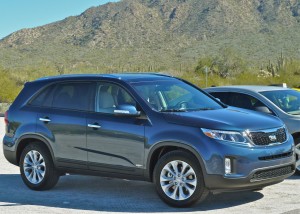
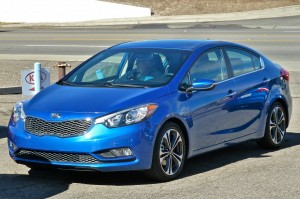
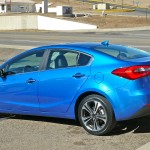
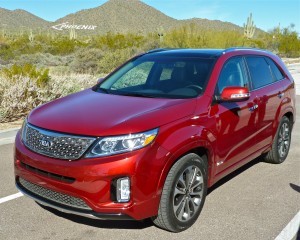
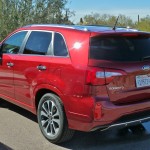
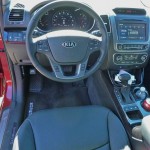
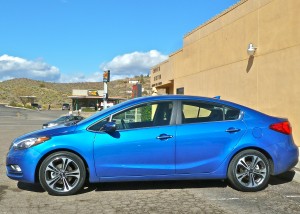
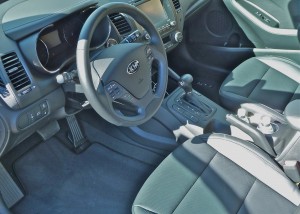
 John Gilbert is a lifetime Minnesotan and career journalist, specializing in cars and sports during and since spending 30 years at the Minneapolis Tribune, now the Star Tribune. More recently, he has continued translating the high-tech world of autos and sharing his passionate insights as a freelance writer/photographer/broadcaster. A member of the prestigious North American Car and Truck of the Year jury since 1993. John can be heard Monday-Friday from 9-11am on 610 KDAL(www.kdal610.com) on the "John Gilbert Show," and writes a column in the Duluth Reader.
John Gilbert is a lifetime Minnesotan and career journalist, specializing in cars and sports during and since spending 30 years at the Minneapolis Tribune, now the Star Tribune. More recently, he has continued translating the high-tech world of autos and sharing his passionate insights as a freelance writer/photographer/broadcaster. A member of the prestigious North American Car and Truck of the Year jury since 1993. John can be heard Monday-Friday from 9-11am on 610 KDAL(www.kdal610.com) on the "John Gilbert Show," and writes a column in the Duluth Reader.